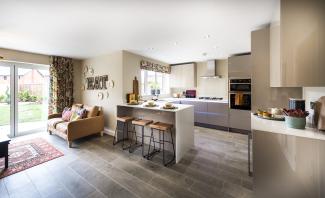Open-plan living areas are incredibly popular these days and for good reason. With an open-plan layout, you’re able to create a larger overall space that allows more natural light to enter. This means more free-flowing energy, better concentration levels, and a happier environment overall. Having a peaceful and calm physical environment is a vital aspect of our well-being. Studies indicate that it boosts our productivity, enhances our immune system, reduces stress and anxiety, and improves physical and mental health.
Organisation is key
Staying organised and creating a calming environment are the keys to achieving peace when living in an open-plan home. There are a few important steps to take to ensure that your open-plan home doesn't become too cluttered or chaotic. Start by making a plan for the layout and design of your home. Decide where your furniture should be placed and how the space will be divided. This will ensure the space is well organised and that work, rest, and play areas are clearly defined.
Decluttering is an essential part of achieving peace in an open-plan home. The more organised your space is, the less overwhelming it will feel when you are in it. Dedicate time each week to tidying up and put things away in designated areas. You could also invest in decorative storage boxes and organisers, to make the process of putting things away faster and more efficient.
A good way to make an open-plan home more calming is to introduce some plants. Not only will plants bring the beauty and serenity of the outdoors inside, but they will also increase the amount of oxygen and reduce the amount of pollutants in the air. They also help to circulate and bounce the light around the room. In addition, hanging a large, indoor/outdoor mirror on the wall will brighten up even the darkest corner.
Create quiet corners
Creating a quiet space in an open-plan home is essential for finding some peace and quiet, and for providing a haven for relaxation. Different areas in the room should be designated for relaxing and for working, so that you can easily switch between the two. A comfortable armchair or loveseat is perfect for creating a restful zone in which to read or simply to enjoy the peace of your home.
You don't have to have a dedicated room to create a calm environment in your open-plan home. Create a comfortable nook in a corner, with a few cushions and a rug to add texture and color to the space. You can hang a tapestry on the wall, add a few pot plants, or place a small table to create an inviting and cozy space to relax in.
Soft music, the sound of running water, or pleasant fragrances are all great ways to help you create a sense of peace. You can also use your home’s lighting to play with creating a cozy and relaxing atmosphere. Soft and warm lighting is perfect for winding down in the evening and having a peaceful night’s sleep.
Design with light
When it comes to open-plan design, it pays to think about how to use the natural light to your advantage. Utilise light, airy colours throughout the whole room, such as whites, creams, and pale greys to keep it bright. This helps to make the most of the available light, as darker colours can absorb the light and make your home feel dull.
You should also consider how the natural light streams through the room during the day, as this will affect how you place furniture. If you have a south-facing room, you’ll no doubt get the maximum amount of daylight and you can use it to your advantage. Conversely, if your area is darker, you may find that your furniture placement needs to be adjusted to make the most of the light.
Furniture and decor: striking a balance with open spaces
Choosing furniture in an open-plan area is all about balance. While you want the space to feel fluid, you also want it to be functional and for each area of the home to have its own identity. Plenty of open-plan living areas include a kitchen, dining, and living room; keep each area separated with furniture items.
When choosing the right furniture, think about what each space requires. In the living room, for example, choose a comfortable sofa and chairs that combine with the colour palette and flooring throughout the space. In the dining room, you’ll want seating and tables that are able to fit comfortably among the other areas, offer storage solutions, and reflect your individual style. Ultimately, your furniture should balance functionality and style while simultaneously not making the space appear cramped.
Creating focal points with decor and accessories
Decor and accessories will help bring personality to your open-plan space while also serving a practical function. A shining example of this is creating a focal point in living areas using artwork, decorative vases or plants. This ensures a visual representation of where each space is meant to be, without creating solid boundaries.
In terms of decor, layering accessories in the same colour group is a popular tactic when creating harmonising living spaces. This will also weaken the visual lines between furniture and living areas allowing each space to work in harmony with one another.
Finding serenity and achieving peace in an open-plan home is an achievable goal. By following the tips mentioned above, you can create a tranquil home that is free from clutter and full of soothing elements that will help you relax and recharge. Stressful work, busy family lives and other life complexities can take a toll on our physical and mental health. Your home should be a haven of peace, where you can unwind, relax and rejuvenate.




